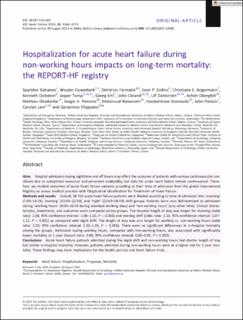Hospitalization for acute heart failure during non-working hours impacts on long-term mortality: the REPORT-HF registry
| dc.contributor.author | Katsanos, Spyridon | |
| dc.contributor.author | Ouwerkerk, Wouter | |
| dc.contributor.author | Farmakis, Dimitrios | |
| dc.contributor.author | Collins, Sean P. | |
| dc.contributor.author | Angermann, Christiane E. | |
| dc.contributor.author | Dickstein, Kenneth | |
| dc.contributor.author | Tomp, Jasper | |
| dc.contributor.author | Ertl, Georg | |
| dc.contributor.author | Cleland, John | |
| dc.contributor.author | Dahlström, Ulf | |
| dc.contributor.author | Obergfell, Achim | |
| dc.contributor.author | Ghadanfar, Mathieu | |
| dc.contributor.author | Perrone, Sergio V. | |
| dc.contributor.author | Hassanein, Mahmoud | |
| dc.contributor.author | Stamoulis, Konstantinos | |
| dc.contributor.author | Parissis, John | |
| dc.contributor.author | Lam, Carolyn | |
| dc.contributor.author | Filippatos, Gerasimos | |
| dc.date.accessioned | 2023-12-28T14:26:24Z | |
| dc.date.available | 2023-12-28T14:26:24Z | |
| dc.date.created | 2023-10-13T12:48:22Z | |
| dc.date.issued | 2023 | |
| dc.identifier.issn | 2055-5822 | |
| dc.identifier.uri | https://hdl.handle.net/11250/3109048 | |
| dc.description.abstract | Aims Hospital admission during nighttime and off hours may affect the outcome of patients with various cardiovascular conditions due to suboptimal resources and personnel availability, but data for acute heart failure remain controversial. Therefore, we studied outcomes of acute heart failure patients according to their time of admission from the global International Registry to assess medical practice with lOngitudinal obseRvation for Treatment of Heart Failure. Methods and results Overall, 18 553 acute heart failure patients were divided according to time of admission into ‘morning’ (7:00–14:59), ‘evening’ (15:00–22:59), and ‘night’ (23:00–06:59) shift groups. Patients were also dichotomized to admission during ‘working hours’ (9:00–16:59 during standard working days) and ‘non-working hours’ (any other time). Clinical characteristics, treatments, and outcomes were compared across groups. The hospital length of stay was longer for morning (odds ratio: 1.08; 95% confidence interval: 1.06–1.10, P < 0.001) and evening shift (odds ratio: 1.10; 95% confidence interval: 1.07–1.12, P < 0.001) as compared with night shift. The length of stay was also longer for working vs. non-working hours (odds ratio: 1.03; 95% confidence interval: 1.02–1.05, P < 0.001). There were no significant differences in in-hospital mortality among the groups. Admission during working hours, compared with non-working hours, was associated with significantly lower mortality at 1 year (hazard ratio: 0.88; 95% confidence interval: 0.80–0.96, P = 0.003). Conclusions Acute heart failure patients admitted during the night shift and non-working hours had shorter length of stay but similar in-hospital mortality. However, patients admitted during non-working hours were at a higher risk for 1 year mortality. These findings may have implications for the health policies and heart failure trials. | en_US |
| dc.language.iso | eng | en_US |
| dc.publisher | Wiley | en_US |
| dc.rights | Attribution-NonCommercial-NoDerivatives 4.0 Internasjonal | * |
| dc.rights.uri | http://creativecommons.org/licenses/by-nc-nd/4.0/deed.no | * |
| dc.title | Hospitalization for acute heart failure during non-working hours impacts on long-term mortality: the REPORT-HF registry | en_US |
| dc.type | Journal article | en_US |
| dc.type | Peer reviewed | en_US |
| dc.description.version | publishedVersion | en_US |
| dc.rights.holder | Copyright 2023 The Author(s) | en_US |
| cristin.ispublished | true | |
| cristin.fulltext | original | |
| cristin.qualitycode | 1 | |
| dc.identifier.doi | 10.1002/ehf2.14506 | |
| dc.identifier.cristin | 2184451 | |
| dc.source.journal | ESC Heart Failure | en_US |
| dc.source.pagenumber | 3164-3173 | en_US |
| dc.identifier.citation | ESC Heart Failure. 2023, 10 (5), 3164-3173. | en_US |
| dc.source.volume | 10 | en_US |
| dc.source.issue | 5 | en_US |
Tilhørende fil(er)
Denne innførselen finnes i følgende samling(er)
-
Department of Clinical Science [2309]
-
Registrations from Cristin [9673]

